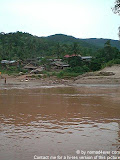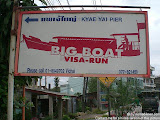 In Singapore or Hong Kong, traffic follows designated laws and common sense rules, issuing driving licenses requires that you learn driving and prove your skills first and pass a driving test afterwards. The rules are enforced by a proper funded and highly motivated Police Force as well.
In Singapore or Hong Kong, traffic follows designated laws and common sense rules, issuing driving licenses requires that you learn driving and prove your skills first and pass a driving test afterwards. The rules are enforced by a proper funded and highly motivated Police Force as well.
So far so good.
Unfortunately, this rosy picture isn’t the case in most other places in Asia, even cities like Bangkok, Kuala Lumpur, Manila or Denpasar are pure Chaos during Rush Hour and still near-battle zones during any other time. Get out to the country-side and it even gets better, as you can run into Ox Carts, 5 people riding 1 bike or trucks loaded up to the horizon with whatever grows on the fields or got killed along the way.
To drive in Asia isn’t as easy as on the wide highways in rural Australia, Europe or the U.S. of A; it might be a Culture Shock to which you better get used to quick.
But don’t worry. Help is near!
You can of course ask a fortune teller first regarding your chances of survival – or better – do like the locals do.
The rules of engagement you may wish to wrap in a handkerchief and put in your sock drawer until needed: if you drive like an American in Makassar or Cebu, you will die like pig fossil. Truly.
To operate a motor vehicle in rural Asia, you must first understand the transportation gestalt in an entirely different way.
Definitions that you thought were above redefinition will immediately be redefined. Please pay attention:
THE ROAD. Includes not only the paved portion of the highway, but also what we might call “the verge”, “the curb”, “the sidewalk”, “the front yard”, “the roadside restaurant”, and “the monastery”. The paved portion of the roadway is generally one lane wide. Not one lane in each direction: one lane.
–
RESPECT. All animals are granted the greatest respect in Asia. It is presumed that being highly evolved creatures, chickens and dogs and the like know how to sidestep a Mitsubishi going 78 mph on a for-shrouded road during a national religious holiday.
This same position of honor is granted to small children, cripples, men with 30 pounds of hay on their heads, unattended oxcarts and elderly women in mystic trances. Slowing or swerving to avoid these beings would cause them dishonor.
–
DISHONOR. Getting from morning to evening while remaining in the same incarnation.
–
LANES. These colorful white and yellow markings wish a hearty “Selamat datang” (Welcome) or “Hi!” to every traveler. They have no other function.
–
PASSING. The national sport of Asian drivers. Observant motorists may encounter the vertical triple (passing three vehicles in one acceleratory movement,) the horizontal triple ( passing a vehicle that itself is in the process of passing a vehicle,) or even the rare double-double (passing a vehicle at precisely the same time that another vehicle, coming in the other direction, is also engaged in the act of passing.)
–
TAILGATING. What to do when not passing.
–
BEING PASSED. An insult not to be endured. The greater the differential between your vehicle (say, a broken tricycle) and the passing vehicle (say, a Boeing 747,) the greater the potential loss of prestige. The owner of the less powerful vehicle must always do everything in his/her power to thwart the attempt to overtake.
–
SEATBELTS. Absolutely unnecessary. Not only are they not worn, they are not even provided. Passengers are fully protected by the horn (see below)
–
LIGHTS. Rapidly blinking the headlights can mean many things, including “OK to pass now,” “dangerous to pass now,” or “may you find the thread of gold in the linen of existence.” It takes years, sometimes entire lifetimes, to learn this subtle and intriguing intuitive nonverbal communication skill. Generally, however, you have about three seconds.
–
THE HORN. When sounded loudly and frequently, the horn sets up an invisible energy barrier protecting the vehicle and its inhabitants from all harm. The faster the vehicle is going, the better the horn works. This is the central concept of Asian motoring.
–
ACCIDENTS. Rare. Usually the result of a malfunctioning horn.
So, now that you understand how traffic works in Asia, we can only wish you “Good Luck!” or even “May the Force be with you!” – the force of-controlling-your-vehicle-properly-the-Asian-way that is.
—
Credits: Found that nice piece of truth (‘definitions’) in the Bali Expat Forum, posted by the user ‘tintin’. It seems to be originally published on 4/11/1988 in the San Francisco Chronicle, written by Jon Carroll.
or save article to your Facebook with 1 simple click:




August 6th, 2007 at 8:57 pm
That is priceless! It reminds me of a harrowing drive through Burma years ago, when traffic drove on the right, but most cars were imported from Japan – with steering wheels also on the right (in case you’re having a moment of confusion, in North America and Western Europe, we drive on the right – and steering wheels are on the left so you can what’s coming towards you).
I recall an amazing drive from the plains of Bagan up the mountains to Inle Lake, with the driver sitting at my right. He would pull out into oncoming traffic, whip around to look at my face – and if I turned pale with terror, he quickly pulled back in. A calm demeanor meant he could pass – on an uphill blind curve, usually.
Of course I rode the bus back down – even though a tire fell off on a mountain edge, at least the steering wheel was where it was supposed to be…
August 9th, 2007 at 8:58 am
Sure you will feel happy that you only have drive experience in Denpasar, Makasar or other city Indonesia because if you have to drive in Jakarta you will think that Denpasar (or other city) driver is very polite.
December 13th, 2008 at 5:44 pm
gosh that is so true!!!…driving in Bali is so much fun (still challenging but much relaxing than driving in Jakarta)!!! LOL
February 2nd, 2011 at 12:54 am
hahaha.. fools. come to india. come to calcutta. there lies the holy shrine of rash driving. i challenge any driver from europe or us to survive 2 hrs of driving thru the city without a scratch in ur car. by the way my car is spotless:) when i go to bangkok i am amazed at how well behaved the traffic is.